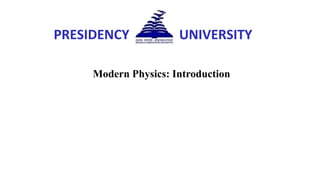
Modern physics
- 1. PRESIDENCY UNIVERSITY Modern Physics: Introduction
- 2. 1. Need and Origin of quantum concept During the late nineteenth century, the study of energy distribution in the spectrum of the blackbody radiation, came up like an insolvable problem. Newtonian mechanics failed to account for the observed spectrum. Therefore, new theory was needed to explain the black body radiation spectrum. In 1900, Max Planck announced his law for explaining the blackbody spectrum in which he adopted a radically different approach to explain the energy distribution. The idea of quanta which he brought forth in his theory, heralded the birth of a new mechanics called quantum mechanics. Whatever knowledge one had in mechanics till then, was branded as classical mechanics. From 1901, onwards quantum mechanics became a major branch of study employed to investigate the mechanics of atomic and sub-atomic particles as Newtonian mechanics fails to explain the same.
- 3. Quantum mechanics is able to explain the phenomenon like photoelectric effect, Compton effect, black body radiation and specific heat of solids which are unable to explain using classical mechanics. 2. Planck’s law of black-body radiation All the theories based on classical ideas failed in one or the other way to explain the black-body radiation spectrum. Wein’s law could explain the blackbody radiation curve only for shorter wavelengths whereas Rayleigh-Jeans’ law worked well only for larger wavelengths. The problem was finally solved in 1901 by Max Planck by proposing quantum theory. Max Planck assumed that walls of the experimental blackbody consists larger number of electrical oscillators. Each oscillator vibrates with its own frequency. 1) Each oscillator has an energy given by integral multiple of hυ where ‘h’ is Planck’s constant & ‘υ’ is the frequency of vibration. E = nhυ where n = 1, 2, 3 . . . etc.
- 4. 2) An oscillator may lose or gain energy by emitting or absorbing respectively radiation of frequency υ where υ=ΔE/h, ΔE is difference in energies of the oscillator before and after the emission or absorption take place. Planck derived an equation which holds good for the entire spectrum of the blackbody radiation as, 𝑈 𝑑 represents spectral energy density of blackbody radiation in the wavelength range λ and λ + dλ. ‘h’ is the Planck’s Constant, ‘c’ is the velocity of light, ‘υ’ is the frequency of radiation and ‘T’ is the temperature of the black body.
- 5. 3. de Broglie’s concept of matter waves We know that radiation has dual nature. In 1924 Louis de Broglie put forth the hypothesis that matter, like radiation, has dual nature, i.e., matter which is made up of discrete particles, atoms, protons, electrons etc., might exhibit wave like properties under appropriate conditions. These waves associated with a moving material particle, are called as matter waves. The wavelength ‘’ associated with a particle of mass ‘m’ moving with a velocity ‘v’ is called de Broglie wavelength and is given by, Where ‘h’ is the Planck’s constant and ‘p’ is the momentum.
- 6. 3.3 Characteristic properties of matter waves
- 7. 3.1 Expression for de Broglie wavelength in terms of energy of the particle
- 8. 3.2 De Broglie wavelength associated with electrons
- 9. 4. Phase Velocity & Group Velocity 4.1 Phase Velocity A progressive wave is represented by the equation, y = Asin(ωt-kx) Where ‘y’ is the displacement along Y-axis at an instant t, ‘ω’ is the angular frequency, ‘k’ is propagation constant or wave number. ‘x’ is the displacement along x-axis at the instant ‘t’. Fig. 1: Point ‘P’ on the progressive wave represents the particular phase of the wave
- 10. “If a point is imagined to be marked on a travelling wave, then it becomes the representative point for a particular phase of the wave and the velocity with which it is transported because of the motion of the wave is called the phase velocity (or wave velocity)”. Or The phase velocity of a wave is the rate at which the phase of the wave propagates in space. The phase velocity of a wave is given by,
- 11. 4.2 Group Velocity Fig. 2: Formation of wave packet by the superposition of waves.
- 12. When a group of two or more waves, differing slightly in wavelengths are superposed on each other, a resultant pattern, emerges in the shape of variation in amplitude. Such a variation represents the wave group as a whole, and called as wave packet. Group velocity is the velocity of the wave packet which is formed due to superposition of two or more traveling waves of slightly different wavelengths. Or Group Velocity is the velocity with which the envelope of the wave packet, propagates through space.
- 13. 4.3 Relation between Group velocity & Phase velocity
- 14. 4.4 Relation between group velocity & particle velocity
- 18. Find the kinetic energy, group velocity and phase velocity of an electron whose de Broglie wavelength is 0.5 n m. Given: = 0.5 nm. E = ?, vg = ?, vp = ? We have, = mE h 2 18 2 31 2 34 2 2 10 5 . 0 10 11 . 9 2 ) 10 625 . 6 ( 2 m h E = 9.635 x 10 – 19 J = 6.015 e V Also, E = 2 2 1 g mv . Hence, group velocity, 31 19 10 11 . 9 10 635 . 9 2 2 m E vg = 1.454 x 10 6 m/s And, phase velocity vp = 6 16 2 10 454 . 1 10 9 g v c = 6.19 x 10 10 m/s